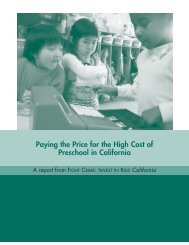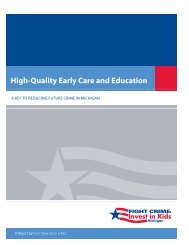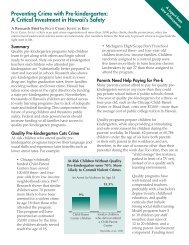California's Next After-School Challenge - Fight Crime: Invest in Kids
California's Next After-School Challenge - Fight Crime: Invest in Kids
California's Next After-School Challenge - Fight Crime: Invest in Kids
You also want an ePaper? Increase the reach of your titles
YUMPU automatically turns print PDFs into web optimized ePapers that Google loves.
Prevent<strong>in</strong>g Teen Sex, Drug and Alcohol<br />
Use, and Smok<strong>in</strong>g<br />
Research shows that quality after-school<br />
programs prevent teen sex, teen pregnancy,<br />
and drug, alcohol and cigarette use by teens.<br />
In California:<br />
• The YouthWORKS after-school program<br />
was established <strong>in</strong> a Sacramento neighborhood<br />
with the highest rate of teen pregnancy <strong>in</strong> the<br />
county. S<strong>in</strong>ce 1998, only one female <strong>in</strong> the<br />
YouthWORKS after-school program became<br />
pregnant while participat<strong>in</strong>g <strong>in</strong> the program.<br />
To the knowledge of program coord<strong>in</strong>ators, no<br />
other participants became pregnant prior to<br />
high school graduation. 19<br />
“students who engaged <strong>in</strong><br />
extracurricular activities were<br />
less likely to engage <strong>in</strong><br />
risky behaviors”<br />
YouthWORKS is an after-school program for<br />
young people ages 12 to 18 that offers a variety<br />
of activities <strong>in</strong>clud<strong>in</strong>g homework assistance, life<br />
skills classes, college and career plann<strong>in</strong>g, and<br />
recreation. The co-ed program serves 140<br />
youths—approximately ten percent of teens <strong>in</strong><br />
the neighborhood.<br />
• A survey of 4,000 California n<strong>in</strong>th graders<br />
found that students who engaged <strong>in</strong><br />
extracurricular activities were less likely to<br />
engage <strong>in</strong> risky behaviors—such as cigarette,<br />
alcohol and marijuana use—than students who<br />
were unsupervised and hang<strong>in</strong>g out. 20<br />
Nationally:<br />
• Inner-city teens were randomly assigned<br />
to the Children’s Aid Society/Carrera afterschool<br />
program <strong>in</strong> New York City or to a<br />
control group. Researchers found, after<br />
controll<strong>in</strong>g for age, ethnicity, family <strong>in</strong>come<br />
and peer behavior, that three years later girls<br />
not <strong>in</strong> the program were three times more<br />
likely to get pregnant and twice as likely to be<br />
sexually active than girls <strong>in</strong> the program. 21<br />
The Children’s Aid Society/Carrera program<br />
operates five days a week after school for three<br />
hours each day. Participants receive academic<br />
support every day and rotate among four other<br />
activities <strong>in</strong>clud<strong>in</strong>g jobs, comprehensive family<br />
life and sex education, arts and sports.<br />
Participants receive stipends for job activities.<br />
• <strong>After</strong> randomly-selected high school<br />
freshmen from welfare families were assigned<br />
to participate <strong>in</strong> the Quantum Opportunities<br />
after-school and graduation <strong>in</strong>centive program,<br />
girls and boys left out were 50 percent more<br />
likely to have children dur<strong>in</strong>g their high school<br />
years. 22<br />
• A study compared over 1,600 high school<br />
participants <strong>in</strong> the Teen Outreach servicelearn<strong>in</strong>g<br />
program at 60 sites across the nation<br />
with a matched comparison group of similar<br />
students. It found, after controll<strong>in</strong>g for<br />
significant background factors related to<br />
pregnancy (race/ethnicity and past history of<br />
pregnancy), that one year later teens not <strong>in</strong> the<br />
program were twice as likely to become<br />
pregnant or get someone pregnant as program<br />
participants. 23<br />
Teen Outreach is offered to n<strong>in</strong>th through<br />
twelfth graders <strong>in</strong> cities across the nation. The<br />
program <strong>in</strong>volves supervised community<br />
service, classroom-based discussions of service<br />
experiences, and classroom-based discussions<br />
and activities related to youth development.<br />
Participants meet <strong>in</strong> classroom sett<strong>in</strong>gs at least<br />
once a week and perform, generally after<br />
school or on weekends, nearly 40 hours of<br />
community service a year. 24<br />
• <strong>After</strong> 18 months, participants <strong>in</strong> the afterschool<br />
program at the South Baltimore Youth<br />
Center were significantly less likely to use<br />
drugs and alcohol than a comparison group,<br />
although they <strong>in</strong>itially had been more likely to<br />
engage <strong>in</strong> such conduct. 25<br />
• A study of 11- to 16-year-olds <strong>in</strong> the Big<br />
Brothers/Big Sisters mentor<strong>in</strong>g program<br />
showed that young applicants randomly<br />
FIGHT CRIME: INVEST IN KIDS CALIFORNIA





